Picking up a guitar for the first time is exciting. Your fingers are itching to play, but where do you even begin? For most aspiring guitarists, the journey starts with chords. But what exactly are chords, and why are they so fundamental? Simply put, chords are the building blocks of harmony in music. They add depth and richness, transforming simple melodies into complete songs. Without chords, music would lack rhythm and feel incomplete. While instruments like drums and bass focus on rhythm and depth, guitars, along with many others, use chords to create the harmonic foundation of music.
Let’s dive into the world of Simple Chords On Guitar, perfect for beginners. We’ll explore different types of easy guitar chords, provide tips and tricks to master them, and even suggest songs you can start playing right away.
At institutions like School of Rock, the emphasis is on practical application. Students immediately apply what they learn, often performing live. This approach highlights the importance of both lead and rhythm guitar skills. Lead guitarists often focus on melodies and solos, while rhythm guitarists are the chord masters, using strumming and fingerpicking to drive the music. Regardless of your style preference, understanding and playing chords is essential. If you’re just starting out and need guidance on selecting your first instrument, consider exploring a helpful guitar-buying guide to make an informed decision.
Understanding Basic Guitar Chord Types
Learning guitar chords can initially seem challenging. There are numerous chord types and ways to play them. However, for beginners, focusing on a few key types simplifies the learning process. Generally, we can categorize simple guitar chords into three main types:
Power Chords: The Rock Starter
Power chords are often among the very first chords guitarists learn, especially at places like School of Rock. Their widespread use across rock, classical, and modern music makes them incredibly valuable. Power chords are considered beginner-friendly because they typically involve only two or three strings and frets. This simpler finger placement makes them physically easier to play. While adaptable to any guitar type, power chords are particularly favored on electric guitars. The distorted sound achievable with electric guitars enhances power chords, adding significant depth and emotion to rock and other genres.
Open Chords: Embracing Open Strings
Open chords are another excellent starting point for beginners. As the name suggests, they incorporate open strings into the chord, meaning some strings are played without being fretted. Similar to power chords, open chords are generally easier to manage as they utilize fewer frets and fingers. However, a key difference is that open chords utilize all six strings of the guitar, creating a fuller sound. Your fretting hand isn’t required for every string, simplifying finger positioning. The foundational open chords are often referred to as CAGED chords, an acronym we’ll explore in more detail shortly.
Barre Chords: Stepping Up Your Chord Game
Barre chords represent a step up in complexity from power and open chords. They can be more challenging initially but become incredibly versatile as you progress. The beauty of barre chords lies in their portability. Once you learn a barre chord shape, you can move it up and down the guitar neck to create different chords without significantly altering finger positions. This makes transitioning between barre chords efficient. However, they are often harder for beginners because they require one or sometimes two fingers to press down multiple strings at the same fret simultaneously – the “barre” technique. While barre chords are crucial for expanding your guitar vocabulary, we’ll focus primarily on open and power chords as simple chords for beginners in this article.
Mastering Open Guitar Chords for Beginners
Before diving into specific open chords, ensure your guitar is properly tuned. Accurate tuning is essential for producing the correct sound and making your practice sessions rewarding. If you’re new to tuning, a helpful guide on tuning your guitar can provide valuable tips to get your instrument sounding its best.
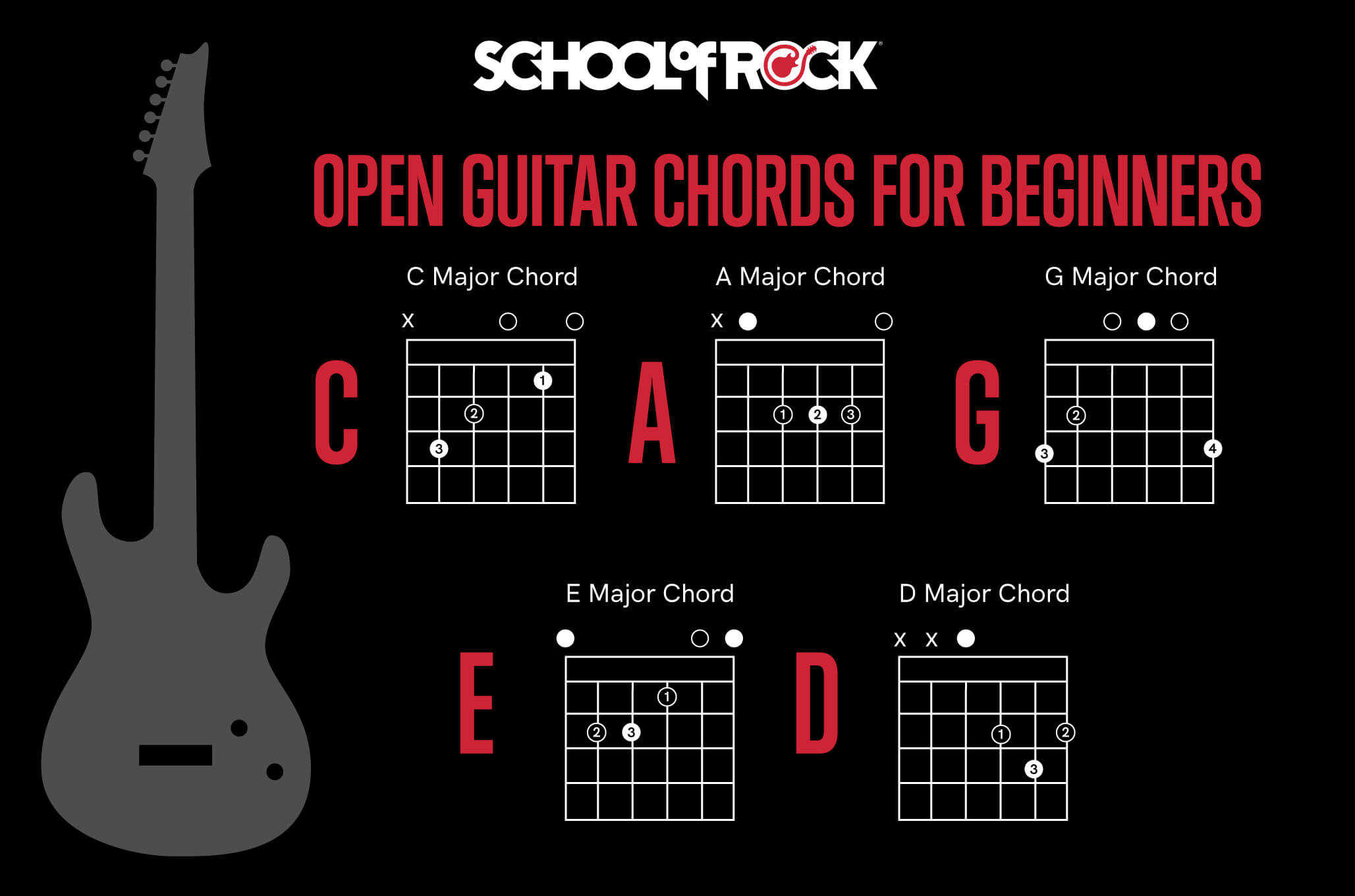 Open Guitar Chords for Beginners
Open Guitar Chords for Beginners
Now, let’s explore open chords, particularly the CAGED system. CAGED is a mnemonic device representing five common open chord shapes: C, A, G, E, and D. This system is a cornerstone of the School of Rock method, as these chords are fundamental to a vast repertoire of popular songs that students perform. The diagrams below illustrate these CAGED chords and others frequently used by beginners.
Decoding Chord Diagrams: A Visual Guide
Chord diagrams are visual representations that show you exactly how to play a chord. They depict the guitar fretboard vertically. The horizontal lines represent the strings, with the top line being the thinnest string (high E) and the bottom line the thickest (low E). Imagine holding your guitar upright – that’s the orientation of the diagram.
- ‘X’ above a string: Indicates a muted string – do not play this string.
- ‘O’ above a string: Indicates an open string – play this string without fretting any note.
- Numbers on the frets: These numbers indicate which finger to use: 1 (index), 2 (middle), 3 (ring), and 4 (pinky). The vertical position of the number shows which fret to press. The top-most row of numbers within the diagram represents the first fret, the next row the second fret, and so on.
For example, in the A Major chord diagram, you’ll see numbers on the second fret across a few strings. This means you’ll be using your index finger (1) on the second fret of the D string, your middle finger (2) on the second fret of the G string, and your ring finger (3) on the second fret of the B string.
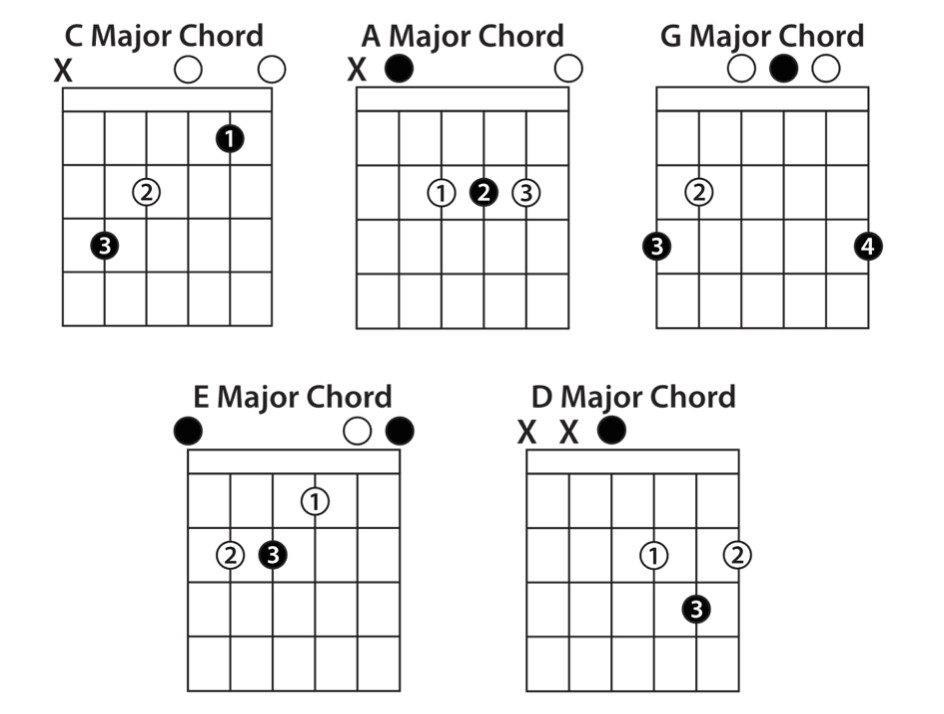 CAGED Chords Diagram
CAGED Chords Diagram
Beyond the CAGED chords, several other open chords are exceptionally useful and easy for beginners to learn. These expand your chord vocabulary and enable you to play a wider range of songs.
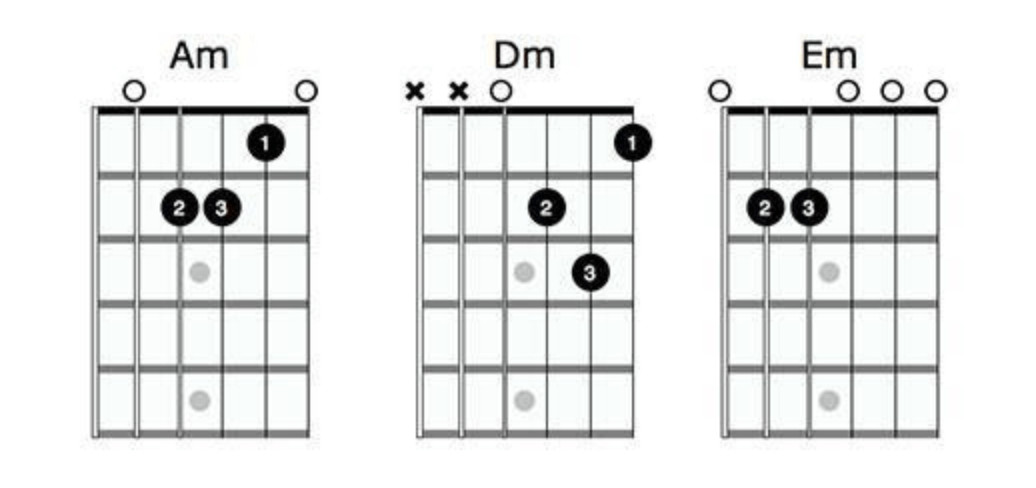 Other Beginner Guitar Chords
Other Beginner Guitar Chords
Chord Diagrams vs. Tablature: Understanding the Difference
It’s important to distinguish chord diagrams from tablature (TAB). While both are visual aids for guitarists, they serve different purposes and are read differently. Tablature is designed to show you where to play specific notes on the guitar, string by string and fret by fret.
In tablature, the horizontal lines represent the guitar strings, but unlike chord diagrams, they are read vertically. The top line is the high E string, and the bottom line is the low E string. Numbers on the lines indicate the fret to be played on that string. ‘0’ represents an open string.
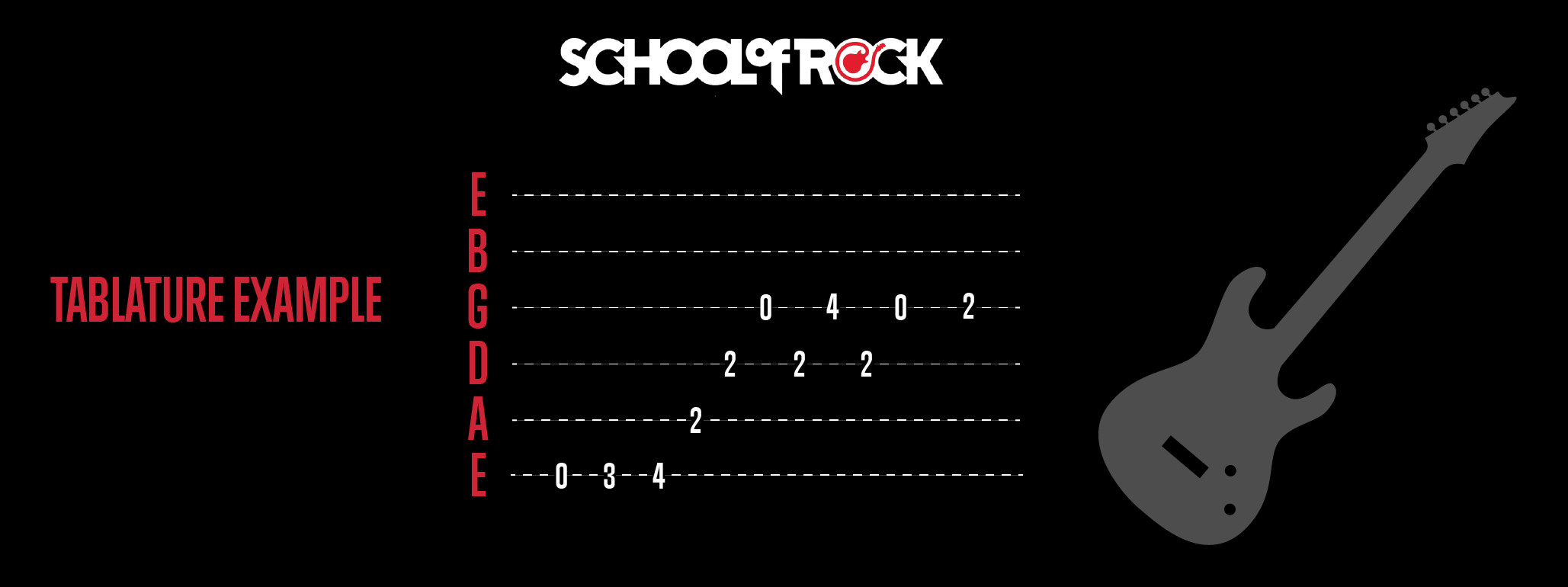 Guitar Tablature Example
Guitar Tablature Example
Chord diagrams focus on finger placement for entire chords, while tablature focuses on individual notes and melodies. Don’t confuse the reading methods of these two essential guitar tools.
Tips for Clean and Clear Chord Playing
Chord diagrams are invaluable for learning finger positions, and they often suggest efficient fingerings for smooth chord transitions. As you practice and build muscle memory, you’ll rely less on the diagrams. To ensure you’re playing chords correctly from the start, keep these tips in mind:
- Fret Close to the Fret Wire: On the guitar neck, metal bars (fret wires) divide the frets. Press down just behind these wires, not directly on top or too far behind. Experiment to find the sweet spot where the note rings out clearly.
- Use Your Fingertips and Arch Your Fingers: Press down with the very tip of your finger. Maintain an arched finger position, like the shape of a ‘C’. This ensures you apply enough pressure for a clear sound and avoid accidentally muting adjacent strings.
- Strum Each String Individually: When learning a new chord, don’t just strum all the strings at once. Play each string separately to check if every note in the chord is sounding clear. This helps you identify any muted strings or buzzing sounds caused by incorrect finger placement.
- Practice Fretting and Unfretting: Practice transitioning into and out of chords. Lift your fingers off the fretboard and then quickly return them to the chord shape. You can even hover your fingers just above the frets in the chord shape to build muscle memory for the finger positions.
Songs to Play Using Simple Guitar Chords
Now that you’ve grasped some basic guitar chords, you’re ready to start playing songs! Many popular songs are built around simple chord progressions, making them perfect for beginner guitarists. Here are a few examples using CAGED chords and some minor chords:
- “Sweet Home Alabama” by Lynyrd Skynyrd: This classic uses just three chords: C, G, and D, making it incredibly accessible for beginners.
- “Bad Moon Rising” by Creedence Clearwater Revival: In the key of D, this song also relies on three chords: G, D, and A.
- “Love Me Do” by The Beatles: This early Beatles hit is in the key of G and uses G, C, and D chords.
- “Eleanor Rigby” by The Beatles: In E minor, this song primarily uses C and variations of Em chords.
- “Time Of Your Life” by Green Day: In G major, this song uses G, C, Cadd9, and D5 power chords. You can easily substitute a regular D major chord for the D5 power chord and it will sound very similar.
- “Island in the Sun” by Weezer: This song features a four-chord progression throughout: Em, Am, D, G. The bridge section uses power chords, offering a chance to practice both open and power chord styles.
- “Boulevard of Broken Dreams” by Green Day: In F minor, this song uses Em, G, D, and A chords. Power chords are also incorporated towards the end, making it another great song for practicing both chord types.
More Popular Songs for Beginner Guitarists:
- “Hey There Delilah” by Plain White T’s
- “Hallelujah” by Leonard Cohen
- “Redemption Song” by Bob Marley
- “Smoke on the Water” by Deep Purple
- “Stairway to Heaven” by Led Zeppelin
- “Hotel California” by Eagles (While “Stairway to Heaven” and “Hotel California” are listed, note they become progressively more challenging beyond basic chords).
Exploring Power Chords Further
Power chords, while simpler than open chords, share similarities with barre chords, particularly in their movable nature. Let’s compare an A major chord and an A5 power chord to understand this better. An A major chord contains the notes A, C#, and E. An A5 power chord contains A and E. The major chord has the root, third, and fifth intervals, while the power chord features the root, fifth, and octave (which is the same note as the root, but an octave higher). Essentially, they share a core sound, but the power chord lacks the third, which is what defines a chord as major or minor. Because power chords lack this third, they are neither major nor minor and can be used in place of either in many musical contexts. Experiment and listen for the sonic difference between open and power chords.
Power chords are often described as simplified barre chords. Three-string power chords can even be played using a “finger barre” technique, where one finger presses down on two strings at the same fret. This is excellent practice for developing the barre technique needed for full barre chords, allowing you to gradually build strength and dexterity.
Power chords are the backbone of many genres, especially classic rock and much of modern pop music. In beginner programs like School of Rock’s Rock 101, power chords are a central focus for learning these styles. Here are some songs that prominently feature power chords:
- “Wild Thing” by The Troggs: This song primarily uses A5, D5, and E5 power chords, with occasional G5 power chords.
- “Let It Be” by The Beatles: You can play this song using either open chords (C, G, Am, F) or power chords. Using C5, G5, and F5 power chords provides a rock-oriented feel.
- “Rock and Roll” by Led Zeppelin: This iconic track is built around A5, D5, and E5 power chords.
- “I Love Rock and Roll” by Joan Jett: This anthem uses E5, A5, and B5 power chords.
- “When I Come Around” by Green Day: This entire song is based on power chords: F#5, C#5m, D#5, and B5.
- “Rockin’ In the Free World” by Neil Young: This song starts with power chords (E5, D5, C5) and then transitions into a mix of open and power chords, incorporating their open chord counterparts (Em, D, and C).
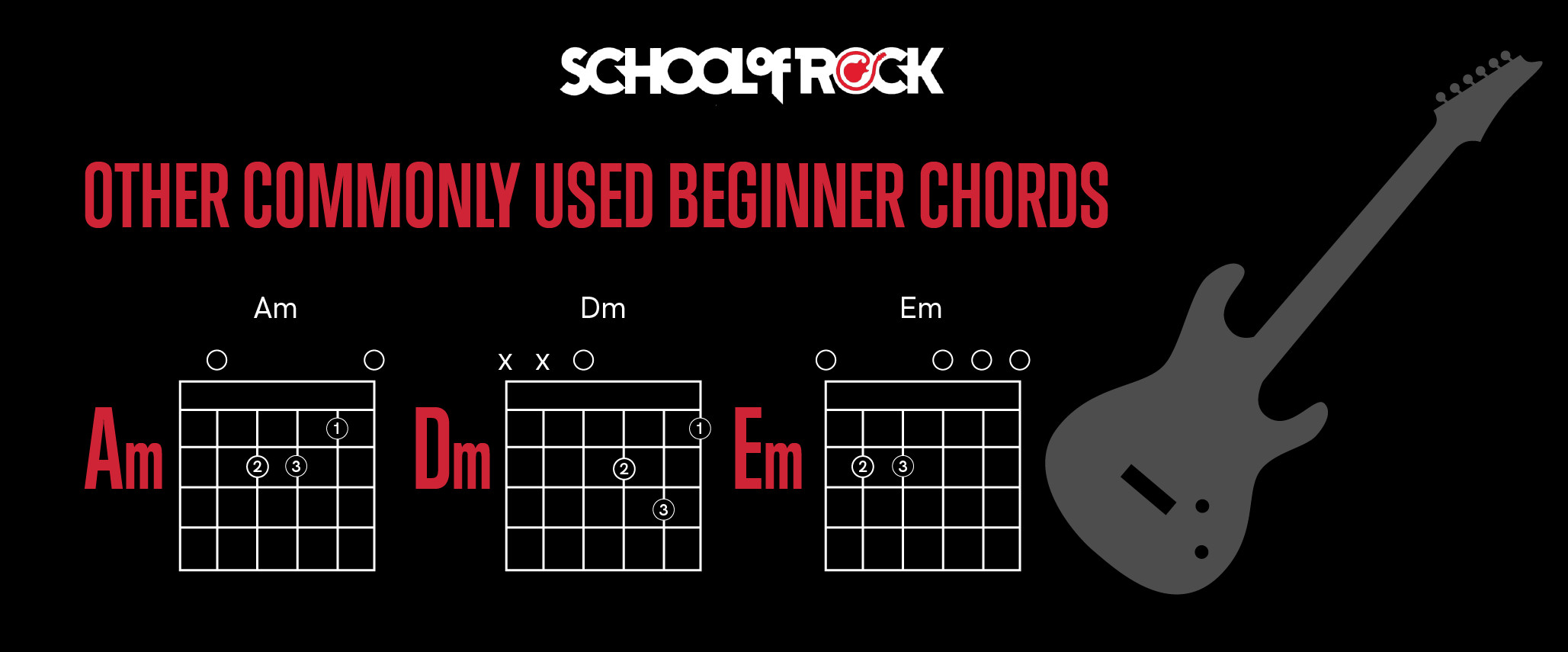 More Beginner Chords
More Beginner Chords
Take Your Guitar Journey to the Next Level
Learning simple chords on guitar is just the beginning of an exciting musical journey. Ready to put your new chord knowledge into practice and explore even more? Whether you desire personalized guidance or a structured learning environment, School of Rock offers various avenues to support your musical growth. Consider exploring private music lessons or their comprehensive music programs designed to get you started on the right path. Programs like Rock 101 and the Performance program bridge the gap between private lessons and real-world performance, allowing beginners and intermediate players to learn full songs and perform with a band. These programs not only teach you open and power chords but also incorporate essential music theory, fostering well-rounded musicianship. To discover more about these opportunities, reach out to your nearest School of Rock location.
Conclusion: Strum Your Way to Guitar Mastery
Mastering simple chords on guitar is the crucial first step in your musical adventure. By understanding open chords and power chords, practicing diligently, and exploring songs that utilize these chords, you’ll quickly build a solid foundation. Remember to practice regularly, focus on clean and clear sound, and most importantly, have fun! With dedication and the right guidance, you’ll be strumming your favorite tunes and progressing towards your guitar goals in no time.
About the Author:
Miranda Morales is a guitar and keyboard instructor at School of Rock Easton in Pennsylvania.

